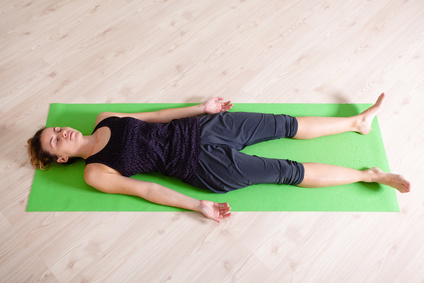📚Yogic Sleep: What you Need to Know
 The fast-paced nature of contemporary life often leads to feelings of stress and anxiety. Many individuals seek relief through different meditation practices, and among them, yogic sleep stands out as a favored technique. With its origins deeply embedded in traditional Indian culture, yogic sleep offers its practitioners a pathway to a more serene and well-balanced existence. This article aims to explore the foundational principles of this meditation technique, instruct on its application, and highlight the potential benefits one might derive from its practice.
The fast-paced nature of contemporary life often leads to feelings of stress and anxiety. Many individuals seek relief through different meditation practices, and among them, yogic sleep stands out as a favored technique. With its origins deeply embedded in traditional Indian culture, yogic sleep offers its practitioners a pathway to a more serene and well-balanced existence. This article aims to explore the foundational principles of this meditation technique, instruct on its application, and highlight the potential benefits one might derive from its practice.
What is Yoga Nidra?
Yoga Nidra, or Yogic Sleep, is a form of meditation that essentially teaches you to consciously take yourself to a stage between being asleep and awake, where you can achieve complete relaxation- both physically and mentally. Many people are skeptical before the first time they try it, but once you do it’ll become part of your regular routine, and become increasingly effective the more experienced you become.
The name is in reference to the Hindu God called Brahma who was responsible for creation. In between the creation of worlds, Brahma would sleep- but, so the story goes, this sleep was never unconscious. This is exactly what is going on during Yogic Sleep.
The intent is to reap the benefits of the healing and restorative functions of a deep sleep without actually having to go to sleep. This way you have full control over the direction you go, and can focus on a deeper understanding of yourself to affect change where you decide it is needed.
The Unique Aspects of Yogic Sleep
The techniques used are very similar to what you will see with meditation, but there are some slight differences that makes it unique.
- First, you position yourself in the most comfortable way possible, which with this particular type of meditation is by lying down. You can also use your pillows and blankets to further achieve this comfort. This is in contrast to most meditation positions which require you to be in a seated position
- Often, with meditation, you will focus on an anchor, such as regular breathing, but here you will guide through a series of stages
- The purpose is to take you to a stage of deep sleep while still being conscious. This is beyond the stage of sleep where you dream, and is where your body recuperates the most. Crucially, though, you won’t actually be asleep, which is why it is described as attaining a state of consciousness between being awake and asleep
An Introductory Technique for Yogic Sleep
If you are keen to try out the idea of yoga for restful sleep, then the following steps will get you started and give you a gentle introduction. As with all forms of meditation, there are many different ways to achieve similar results, so if you enjoy what you experience you are encouraged to research other methods alongside these steps to perfect your own routine.
To start with you should prepare a comfortable space for you to lie down. Use a yoga mat, mattress, pillows, blankets, and whatever else makes you feel relaxed. Dim the lights, and eliminate all other distractions from the room. Now, flat on your back, arms stretched by your sides, eyes closed, and with your palms facing upwards, you are ready to begin:
- Relax. To start with you should relax yourself with calming breathing exercises that will help you unwind and prepare your nervous system for the next stages.
- Intent. Next it is time to decide upon your intention, or “Sankalpa”. This is anything you want to encourage more in your life- whether it be strength, courage, confidence, or any other desire you have.
- Calm. Now focus on what makes you feel safe and calm. This can be a person, a place, an object, or an experience- let the thought take over and embrace the feelings of security and happiness. You can return to this stage at any time you wish.
- The Body. Let your sense of being traverse your body. Feel it flowing from your head, through your nose, mouth, jaw, ears, and eyes before it moves on to your arms, hands, torso, down through your hips, thighs, legs, and feet. Feel your consciousness exuding through your entire body as burgeoning warmth.
- Breath. Focus now on how your breath is automatic. Feel the air as it is breathed in, as your chest rises, and then as it is all expelled.
- Embrace Your Emotion. Allow your emotions and feelings to take hold, but don’t try to control them. Whether it’s happiness, sadness, warmth, or fear- do not worry, but if you feel uncomfortable you should think back to the happy place from earlier.
- Thoughts. Let your current thoughts come to the fore. Think of the present memories and images that are floating around your mind, and when you face beliefs you have about yourself, investigate the opposites too, and enjoy the sensation.
- Joy. Encourage feelings of joy to flow through your body. As you breath, let these feelings take over and think of them as warmth being emitted from all over.
- Yourself. Think about yourself and what is important to you and your desires. Think of yourself as an observer looking back at you, and let these feelings blend into one.
- Reflection. As you reach the end of your session, think back on the experience you have just gone through. Reaffirm your feelings of purity, and imaging combining these senses with what you experience in your waking life in both nice and tricky situations.
- Return. In your own time it is now time to wake yourself, and become aware of your surroundings once more. There’s no rush at this stage, and do it at the speed you feel comfortable.
How to Perfect the Process
As said before, the most important things you can have to help with your meditation is the bedding required to ensure you feel completely comfortable. This allows you to focus on the meditative technique without any distractions. Get rid of unpredictable sounds and lights, and lie on a mattress and pillows that fully support your body.
It’s also worth investigating in different audio recordings of meditation tutors and buying one that aligns with your aims. It’s a lot easier if there’s a calming voice that talks you through the different stages and is a constant presence that guides you through the process.
How Does it Work?
It’s a fair question to ask of why this is beneficial as opposed to you simply practicing yoga before bed. Rather than stretching your body and relaxing yourself that way, this particular practice focuses more on your mental state, and how you can encourage your body to heal itself in the same way it would when you are asleep.
Each of the steps are designed to help you fall into a deeper state of an altered consciousness, where your mind is opened up to new ideas, new ways of approaching challenges, and helping reach your goals. It can, therefore, not only help you to relax and reduce stress and anxiety, but also help you towards positive affirmations about your life, and the directions you want to be going in.
The Benefits of Yogic Sleep
There are a number of improvements that Yoga Nidra can help you with. It focuses on both mental and physical states of being by helping you transition between different states of consciousness. It can be very good for:
- Helping with insomnia
- Reduce your levels of stress
- Help to manage anxiety
- Improve focus and overall awareness
- Help you assess your behaviors and thoughts and alter the undesirable ones
- Encourage a sense of calm, peace, and serenity
- Confront issues as a result of PTSD
- Pain management
Pushing your body into a state of near deep sleep will cause it to regenerate in the way it would when you are asleep. This means that your body will physically start to restore itself, and get effective rest and relaxation. Some studies suggest that 45 minutes of this yoga will give you the same restorative benefits you would get with 3 hours of normal sleep.
The Final Verdict
If you experience heightened levels of stress, anxiety, insomnia, or a number of other issues that can result from a hectic schedule, then Yoga Nidra could be worth thinking about. It is a form of meditation that encourages you to relax and think about your goals, and what needs to change for you to reach them.
Yogic Sleep is easily accessible, because all you need is a comfortable place to lie down. Beyond that you simply need to free up an hour a day without distraction where you can focus on your sense of self and wellbeing.






